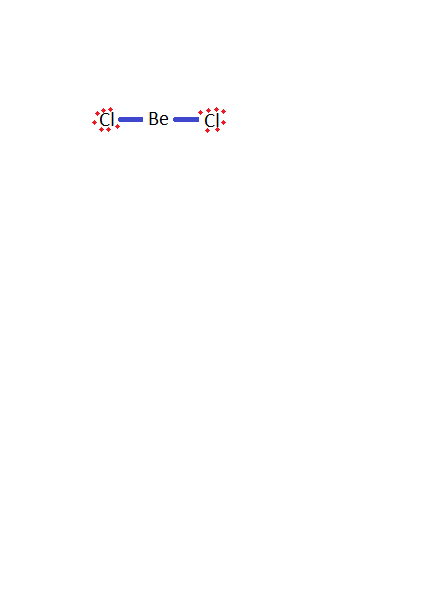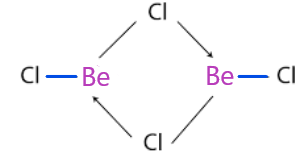
How many 3C - 4${{\text{e}}^{-}}$ bonds are present in the dimer of $\text{BeC}{{\text{l}}_{2}}$?
Answer
575.4k+ views
Hint: 3C-4${{\text{e}}^{-}}$ bonds stands for three centre - 4 electron bonds. Coordination bonds are those bonds which are made after the sharing of lone pair electrons. 3C-4${{\text{e}}^{-}}$ bond means that in between 3 atoms total 4 electrons are shared which do not participate in the reaction.
Complete answer:
-Firstly, we have to draw the structure of beryllium chloride.

-Now, here chlorine has a lone pair of an electron which can be shared with the other molecules which are electron deficient.
-So, beryllium chloride dimerises to form \[\text{B}{{\text{e}}_{2}}\text{C}{{\text{l}}_{4}}\] because it is unstable due to incomplete octet present in the boron and the structure of it is:

-So, we can see that the two molecules of chlorine share the lone pair of an electron with boron to fulfill the octet.
-Also, the compound is an electron-deficient molecule because electron-deficient molecules are those in which the total no. of atoms in the boron is less than 8.
-As we can also see that four-electrons are being shared, that is two electrons from each chlorine atom and they are given to the boron.
-So, a total of 3 atoms participated that's why it is called 3 centre - 4 electron bond.
-And a total of two bonds are formed.
Therefore, total 2, 3C - 4${{\text{e}}^{-}}$ bonds in the structure of beryllium chloride.
Note: Electron deficient molecules tend to accept electrons so they can make coordinate bonds easily. Other molecules which can form 3C - 4${{\text{e}}^{-}}$bonds are \[\text{Xe}{{\text{F}}_{2}}\text{, A}{{\text{l}}_{2}}\text{C}{{\text{l}}_{6}}\text{, HF, etc}\]. Electron rich molecules are those species which have an extra pair of electrons to make the bond with electron deficient molecules.
Complete answer:
-Firstly, we have to draw the structure of beryllium chloride.

-Now, here chlorine has a lone pair of an electron which can be shared with the other molecules which are electron deficient.
-So, beryllium chloride dimerises to form \[\text{B}{{\text{e}}_{2}}\text{C}{{\text{l}}_{4}}\] because it is unstable due to incomplete octet present in the boron and the structure of it is:

-So, we can see that the two molecules of chlorine share the lone pair of an electron with boron to fulfill the octet.
-Also, the compound is an electron-deficient molecule because electron-deficient molecules are those in which the total no. of atoms in the boron is less than 8.
-As we can also see that four-electrons are being shared, that is two electrons from each chlorine atom and they are given to the boron.
-So, a total of 3 atoms participated that's why it is called 3 centre - 4 electron bond.
-And a total of two bonds are formed.
Therefore, total 2, 3C - 4${{\text{e}}^{-}}$ bonds in the structure of beryllium chloride.
Note: Electron deficient molecules tend to accept electrons so they can make coordinate bonds easily. Other molecules which can form 3C - 4${{\text{e}}^{-}}$bonds are \[\text{Xe}{{\text{F}}_{2}}\text{, A}{{\text{l}}_{2}}\text{C}{{\text{l}}_{6}}\text{, HF, etc}\]. Electron rich molecules are those species which have an extra pair of electrons to make the bond with electron deficient molecules.
Recently Updated Pages
Master Class 12 Business Studies: Engaging Questions & Answers for Success

Master Class 12 Economics: Engaging Questions & Answers for Success

Master Class 12 English: Engaging Questions & Answers for Success

Master Class 12 Maths: Engaging Questions & Answers for Success

Master Class 12 Social Science: Engaging Questions & Answers for Success

Master Class 12 Chemistry: Engaging Questions & Answers for Success

Trending doubts
What are the major means of transport Explain each class 12 social science CBSE

Which are the Top 10 Largest Countries of the World?

Draw a labelled sketch of the human eye class 12 physics CBSE

How much time does it take to bleed after eating p class 12 biology CBSE

Explain sex determination in humans with line diag class 12 biology CBSE

Differentiate between homogeneous and heterogeneous class 12 chemistry CBSE




